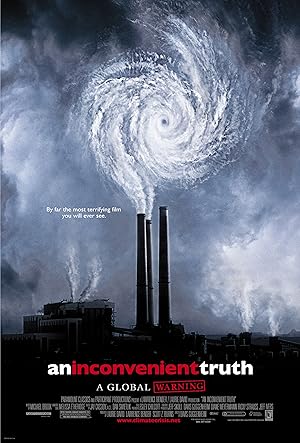
An Inconvenient Truth
You look at that river
gently flowing by.
You notice the leaves
rustling with the wind.
You hear the birds.
You hear the tree frogs.
In the distance, you hear a cow.
You feel the grass.
on the river bank.
It's quiet. It's peaceful.
And all of a sudden,
it's a gear shift inside you.
And it's like taking a deep breath
and going,
"Oh, yeah, I forgot about this."
This is the first picture of the Earth
from space
that any of us ever saw.
It was taken on Christmas Eve, 1968
during the Apollo 8 Mission.
...within relatively comfortable
boundaries.
But we are filling up that thin shell
of atmosphere with pollution.
Ladies and gentlemen,
Mr. Al Gore.
I am Al Gore.
I used to be the next president
of the United States Of America.
I don't find that particularly funny.
I've been trying to tell this story
for a long time,
and I feel as if I've failed to get
the message across.
I was in politics for a long time
and I'm proud of my service.
This is a national disaster.
Get every doggone Greyhound bus line
in the country,
and get their... moving to
New Orleans.
That's them thinking small, man,
and this is a major, major, major deal.
What do you need right now?
There are good people,
who are in politics in both parties
who hold this at arm's length
because if they acknowledge it
and recognize it,
then the moral imperative to make
big changes
is inescapable.
... unless you fix the biggest damn crisis
in the history of this country.
...scouted out landing spots
and they lost radio contact
when they went around
the dark side of the moon.
And there was inevitably
some suspense.
Then when they came back
in radio contact,
they looked up
and they snapped this picture,
and it became known as Earth Rise.
And that one picture exploded
in the consciousness of humankind.
It lead to dramatic changes.
Within 18 months of this picture,
the modern environmental movement
had begun.
The next picture was taken on the last
of the Apollo missions,
Apollo 17.
This one was taken
on December 11, 1972,
and it is the most commonly published
photograph in all of history.
And it's the only picture of the Earth
from space that we have
where the sun was directly
behind the spacecraft
so that the Earth is fully lit up
and not partly in darkness.
The next image I'm gonna show you
has almost never been seen.
It was taken by a spacecraft
called The Galileo
that went out to explore
the solar system.
And as it was leaving Earth's gravity,
and took a time lapse picture
of one day's worth of rotation,
here compressed into 24 seconds.
Isn't that beautiful?
This image is a magical image in a way.
It was made by a friend of mine,
Tom Van Sant.
He took 3,000 separate
satellite pictures
taken over a three-year period,
digitally stitched together.
And he chose images
that would give a cloud-free view
of every square inch
of the Earth's surface.
All of the land masses
accurately portrayed.
When that's all spread out,
I show this because I wanna tell you
a story about two teachers I had.
One that I didn't like that much,
the other who is a real hero to me.
who taught geography
by pulling a map of the world down
in front of the blackboard.
I had a classmate in the sixth grade
who raised his hand
and he pointed to the outline
of the east coast of South America
and he pointed
to the west coast of Africa
and he asked,
"Did they ever fit together?"
And he asked,
"Did they ever fit together?"
And the teacher said,
"Of course not. That's the most
ridiculous thing I've ever heard."
That student went on to become
a drug addict and a ne'er-do-well.
The teacher went on to become
science advisor
in the current administration.
But, you know,
the teacher was actually reflecting
the conclusion of the scientific
establishment of that time.
Continents are so big,
obviously they don't move.
But, actually, as we now know,
they did move.
They moved apart from one another.
But at one time they did,
in fact, fit together.
But that assumption was a problem.
It reflected the well-known wisdom
that what gets us into trouble
is not what we don't know,
it's what we know for sure
that just ain't so.
This is actually an important point,
believe it or not,
because there is another
such assumption
that a lot of people have in their minds
right now about global warming
that just ain't so.
The assumption is something like this.
The Earth is so big
we can't possibly have
on the Earth's environment.
And maybe that was true at one time,
but it's not anymore.
And one of the reasons
it's not true anymore
is that the most vulnerable part
of the Earth's ecological system
is the atmosphere.
Vulnerable because it's so thin.
My friend, the late Carl Sagan,
used to say,
"If you had a big globe
with a coat of varnish on it,
"the thickness of that varnish
relative to that globe
"is pretty much the same
"as the thickness
of the Earth's atmosphere
"compared to the Earth itself."
And it's thin enough
that we are capable
of changing its composition.
That brings up the basic science
of global warming.
And I'm not gonna spend a lot of time
on this because you know it well.
in the form of light waves
and that heats up the Earth.
And then some of the radiation
that is absorbed and warms the Earth
is reradiated back into space
in the form of infrared radiation.
And some of the outgoing
infrared radiation is trapped
by this layer of atmosphere
and held inside the atmosphere.
And that's a good thing because
it keeps the temperature of the Earth
within certain boundaries,
keeps it relatively constant and livable.
But the problem is this thin layer
of atmosphere is being thickened
by all of the global warming pollution
that's being put up there.
And what that does is
it thickens this layer of atmosphere,
more of the outgoing infrared is trapped.
And so the atmosphere heats up
worldwide. That's global warming.
Now, that's the traditional explanation.
Here's what I think is
a better explanation.
You're probably wondering
why your ice cream went away.
Well, Susie, the culprit isn't foreigners.
It's global warming.
- Global...
- Yeah.
Meet Mr. Sunbeam.
He comes all the way from the sun
to visit Earth.
Hello, Earth.
Just popping in to brighten your day.
And now I'll be on my way.
Not so fast, Sunbeam.
We're greenhouse gases.
You ain't going nowhere.
Oh, God, it hurts.
Pretty soon, Earth is chock-full
of Sunbeams.
Their rotting corpses heating
our atmosphere.
How do we get rid
of the greenhouse grasses?
Fortunately, our handsomest politicians
came up with a cheap, last-minute way
to combat global warming.
Ever since 2063,
Translation
Translate and read this script in other languages:
Select another language:
- - Select -
- 简体中文 (Chinese - Simplified)
- 繁體中文 (Chinese - Traditional)
- Español (Spanish)
- Esperanto (Esperanto)
- 日本語 (Japanese)
- Português (Portuguese)
- Deutsch (German)
- العربية (Arabic)
- Français (French)
- Русский (Russian)
- ಕನ್ನಡ (Kannada)
- 한국어 (Korean)
- עברית (Hebrew)
- Gaeilge (Irish)
- Українська (Ukrainian)
- اردو (Urdu)
- Magyar (Hungarian)
- मानक हिन्दी (Hindi)
- Indonesia (Indonesian)
- Italiano (Italian)
- தமிழ் (Tamil)
- Türkçe (Turkish)
- తెలుగు (Telugu)
- ภาษาไทย (Thai)
- Tiếng Việt (Vietnamese)
- Čeština (Czech)
- Polski (Polish)
- Bahasa Indonesia (Indonesian)
- Românește (Romanian)
- Nederlands (Dutch)
- Ελληνικά (Greek)
- Latinum (Latin)
- Svenska (Swedish)
- Dansk (Danish)
- Suomi (Finnish)
- فارسی (Persian)
- ייִדיש (Yiddish)
- հայերեն (Armenian)
- Norsk (Norwegian)
- English (English)
Citation
Use the citation below to add this screenplay to your bibliography:
Style:MLAChicagoAPA
"An Inconvenient Truth" Scripts.com. STANDS4 LLC, 2025. Web. 22 Feb. 2025. <https://www.scripts.com/script/an_inconvenient_truth_2787>.







Discuss this script with the community:
Report Comment
We're doing our best to make sure our content is useful, accurate and safe.
If by any chance you spot an inappropriate comment while navigating through our website please use this form to let us know, and we'll take care of it shortly.
Attachment
You need to be logged in to favorite.
Log In